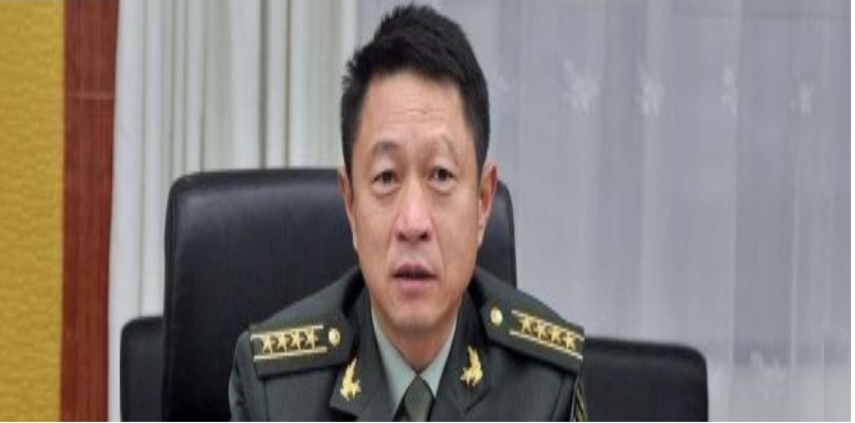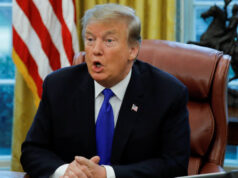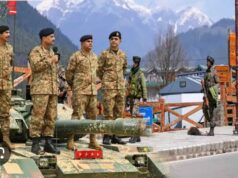CMC Under Tension : Removes Western Theatre Commander once Again

The ongoing tensions on the LAC between India and Chinese Occupied Ladakh in the North and on the MacMohan line between India and Chinese Occupied Tibet in the East has caused considerable TENSION in the Chinese Military Commission, though it is of their own making.
Now the recent American and allied pull out from Afghanistan, has further raised the pressure and therefore the importance of the Western Theatre Command of the People’s Liberation Army (PLA) has been growing in China’s strategic reckoning causing more tensions.
This was confirmed on September 6 when Chairman Xi Jinping presided over a ceremony promoting five senior officers. The five lieutenant generals (two from the army, one from the navy and two from the air force) were promoted to general/ admiral, the PLA’s highest rank. These officers have been given command of the PLA Navy (PLAN), PLA Air Force (PLAAF), National Defence University and two of five HQ theatres.
Due to this promotions an army general will now head the Central Theatre, replacing the PLAAF general. This means all five theatre now have an army general in Command. For all the talk of joint warfare and the PLA becoming less ground-centric, it seems that “Big Army” thinking still dominates within the PLA. This could be seen as a retrograde step, even if the current situation is changed in the future.
Interestingly, this was the third three-star ceremony in less than nine months. Four Officers were promoted on December 18, 2020 and another four on July 5, 2021. Traditionally, such promotion ceremonies occurred only annually in July.
The newly promoted General Wang Haijiang, is now the Commander of the Western Theatre. The assignment of this third new commander to the Western Theatre in less than two years is an unexplained phenomenon during the period in which China and India have been engaged in a tense and deadly LAC confrontation in Aksai Chin.
Fifty-eight-year-old Wang was first in protocol order during the ceremony. Born in October 1963, he received his second star in December 2019, less than two years ago. He was previously Commander, Xinjiang Military District (March-August 2021) and, before that, Commander, Tibet Military District (December 2019 to February 2021) and Deputy Commander, Tibet Military District (from 2016).
Even further back he was Commander of Nanjiang (Southern Xinjiang) Military District and Commander of the 61st Division in the Lanzhou Military Region. General Wang has thus had all his command experience in the Western Theatre. Wang replaced General Xu Qiling, who was appointed head of the Western Theatre just two months ago in July. Prior to that, he had spent two months as Army Commander in the Western Theatre. That was his first assignment in China’s west, unlike the vastly greater regional experience of Wang.
Wang Haijiang has long experience in Xinjiang and Tibet…and would be familiar with the operational, geographic and cultural conditions in the Western Theatre. Wang’s background has prepared him for leading the theatre during the standoff with India in the Aksai Chin.
Left unsaid by official Chinese sources is why there has been so much turnover in the Western Theatre Command commander over the past two years – is this an example of ‘ticket-punching’ for selected officers to groom them for higher responsibility, or did something go wrong that led to their early departure?
The above means that things are indeed not going as per the plans of the Chinese Central Military Commission and therefore Xi has been forced to remove the Commander of Western Theatre.
Xu’s fate is not yet known, but it is possible he could be in line for a follow-on lateral assignment. The again, a great number of senior PLA officers have also been netted by Xi’s anti-graft campaign. With most of his career spent in the Eastern and Northern Theatre Commands, it is possible the CMC was very unhappy with his performance on the LAC.
At 59, he should have six more years at a theatre-level grade. Therefore, his next stage should be of great interest to ascertain whether he has been promoted or side lined. Xu had himself replaced General Zhang Xudong, who was in charge for just six months (December 2020 till June 2021). Similarly, Zhang had little experience in China’s west.
This rapid turnover stands in sharp contrast to General Zhao Zongqi, who was in command there for nearly five years prior to that. Perhaps this revolving door shows the CMC is unhappy with how events have played out along the Indian border.
Of the PLA’s 37 full generals/admirals, at least nine will reach retirement age of 65 before the 20th Party Congress in 2022. Thus, new members of the CMC will eventuate at that time. 2022 is likely to be turbulent as roughly two dozen theatre leader-grade generals and admirals vie for promotion to these most senior leadership positions. It is unclear how the recent three-star promotions fit into that puzzle.
Of course, political loyalty to Xi plays an important role in high-level promotions. While Xi presumably plays a personal role in selecting senior officers, exact details are unknown. All senior PLA officers are senior communist party members and therefore “Xi’s men”.
Personal fealty to Xi will be part of the promotion package. The churn of PLA commanders in the Western theatre underscores the importance of the region. China is afraid of Islamic terrorism spilling over from Afghanistan into Xinjiang, and violence exploded last year in Eastern Ladakh along the LAC between Chinese Occupied Ladhak and Indian. Indeed, the LAC has become a key flashpoint in the Indo-Pacific region, resulting in more Chinese and Indian troops being stationed near the border, as well as infrastructure construction to allow more rapid insertion of troops.
The Chinese military’s activities on the contested LAC have been one of the key drivers behind the shift in the Indian public’s and government’s assessments of India’s relationship with China. The result has been a faster convergence in regional security and strategic policy directions. One example of this is the revival of the Quad partnership.
China and India have both continued their infrastructure build-up along the LAC since 2017. This includes frontline observation towers and forward troop bases. Indeed, China accelerated construction after the Doklam humiliating standoff, including more recently a rear road stretching 5km over treacherous mountain terrain.
The road project is significant in both its scale and its importance for facilitating PLA operations in a key part of the contested China – Bhutan border region by helping China bridge tactical gaps overlooking crucial Bhutanese and even Indian territory. The road aims south towards the Jampheri Ridge, and many new installations are largely out of sight of Indian positions, giving the PLA the element of concealment and tactical surprise.
Chinese positions are generally fewer than those of India, and are placed farther back from the border. On the other hand, its barracks and transport infrastructure allow it to rapidly reinforce the border. China has once again allowed its military to continue building strategic road infrastructure towards Indian territory.
Though India maintains a surveillance advantage throughout the Doklam area with frontline positions abutting the border. Key to this is maintaining control of the Jampheri Ridge, for if China occupies this feature it would have clear sight over the Siliguri Corridor that gives India access to its north-eastern states.
PLA was thoroughly humiliated by its foray into the Bhutanese territory, but it can be observed that Doklam’s ad hoc disengagement agreements did not change the long-term conditions or strategic and territorial imperatives of China.
China is adept at using negotiations to draw out tensions and to frustrate other sides, as seen in ASEAN negotiations for a Code of Conduct for the South China Sea. However now things are different in New Delhi and Beijing itself US getting outsmarted at every step.
China and India may negotiate on tactical positions, but neither side will sacrifice their broader strategic advantages along the LAC. Troops remaining in close proximity, disagreement over where the border is, and assertiveness of each side are all risk factors. Thus, should China continue to seek to change the status quo, then escalatory risks will grow.
Doklam, lessens have already been applied In Eastern Ladakh where China attempted to grab territory. In Galwan the PLA received a very bloody nose with 40 of its soldiers killed and as many wounded. India’s incursion into disputed territory could provide a successful model to deter Chinese expansionism, and thus force China to reassess its goals. China is becoming aware that its nightmares are about to start in Xinjiang and rest of Eastern Turkmenistan. Tibet will soon follow.
Disengagement in Eastern Ladakh started in February, nonetheless, the PLA has been augmenting its capabilities there, creating new barracks, heliports and other facilities, even through the bitter winter months. It has expanded its combat power and build permanent infrastructure to sustain and support a long-term presence as well as to surge forces.
However Indian Army has not only doubled its strength in Ladakh but now has a bigger offensive capability too.
The Ladakh crisis between China and India seems to have settled into a stalemate, marked by somewhat reduced tactical tensions and continuing fruitless talks on disengagement – but it could again turn suddenly, even flaring into a limited conventional war. Despite a limited disengagement, both sides continue to make military preparations near the Line of Actual Control (LAC) to increase their readiness for potential conflict.
The broader political context is marked by distrust and hostility, and bilateral relations are at their lowest ebb in decades. War remains unlikely – both sides can ill-afford the distraction from higher national priorities, and have demonstrated a recent keenness to step back from the brink.
China tried its out its South China Sea strategy in Ladakh too and in the bargain received a bloody nose this time. This much is evident from the dramatic turnover in the Western Theatre, perhaps Xi and the CMC are agitating for more decisive results against India. Future forays across the LAC may yet occur which may end the era of Xi himself.




